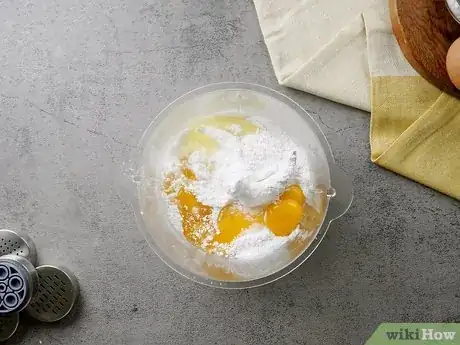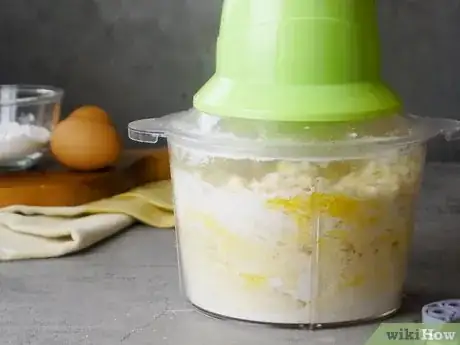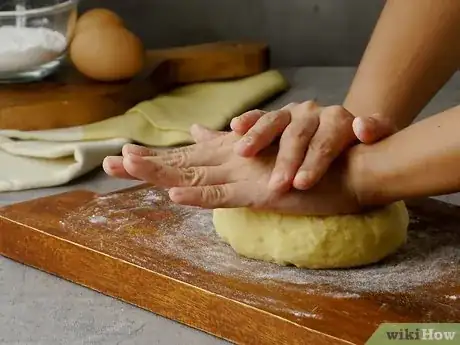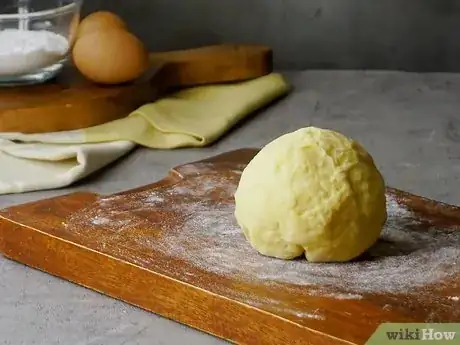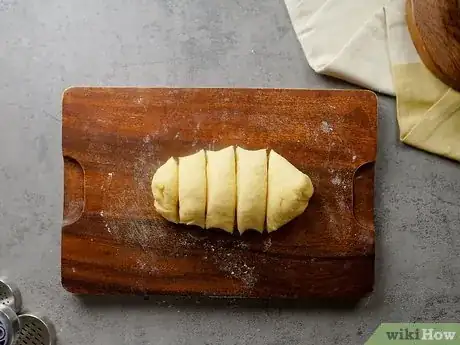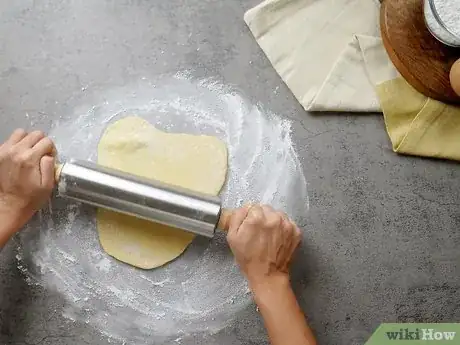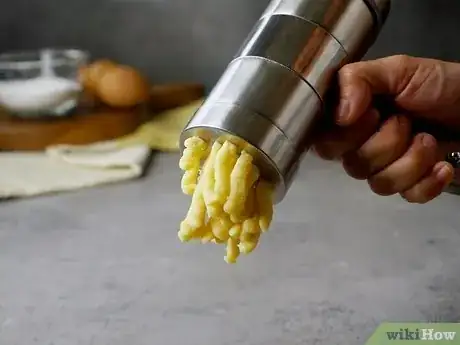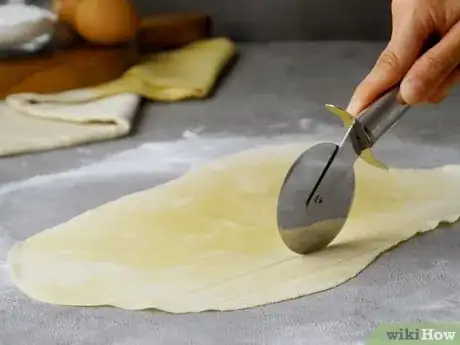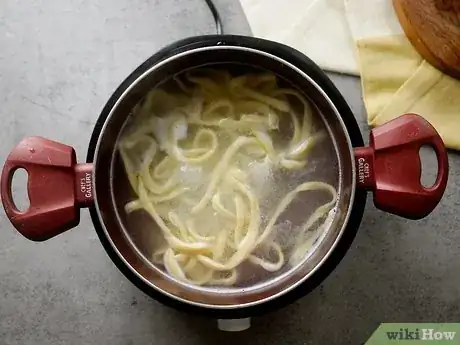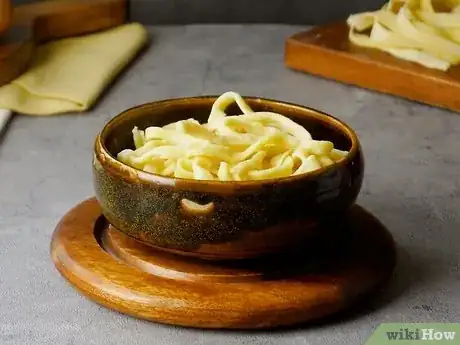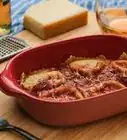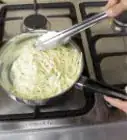This article was co-authored by Thuong Tan. Thuong Tan is a Noodle Expert and the Founder of Noodelist, a food startup producing plant-based instant noodles. Thuong holds a Bachelor’s degree in International Business and Marketing from Haaga-Helia, University of Applied Sciences, and an MBA in Luxury Brand Management from IFA Paris, Polimoda/Shanghai University. Noodelist’s mission is to produce premium plant-based moroheiya noodles that are nutrient-dense, texturally pleasing, and environmentally friendly.
There are 7 references cited in this article, which can be found at the bottom of the page.
This article has been viewed 58,034 times.
This egg and flour dough creates a much more silky, flavorful pasta than you'd get in a box. You don't even need a pasta machine to make it, although it will save you time. Once finished, the noodles taste best when cooked immediately.
Ingredients
Makes 1 pound (0.45 kilograms) pasta; Serves 4 to 6
- 2 cups (10 oz) all-purpose flour
- 2 large eggs
- 4 additional large egg yolks
- 1 tsp (5 mL) salt (iodized or kosher; not sea salt)
- 2 tsp (10 mL) olive oil (for easier hand rolling, if you don't have a pasta machine)
Steps
Making the Dough
-
1Combine all ingredients. Start by mixing all the ingredients together, form. There are several ways to accomplish this:
- In a food processor, pulse a few times to combine, then process for about 45 seconds.[1]
- In a stand mixer, combine with a flat beater for 30–60 seconds. Switch to a dough hook attachment and mix at medium speed for another 2 minutes.[2]
- By hand, add flour and salt to a bowl and form a 4 inch (10 cm) "well" in the center. Beat eggs and egg yolks together, then pour into the well. Slowly push flour into the egg with a fork, until you've formed a soft dough.[3]
-
2Make adjustments. The brand of flour, size of eggs, and humidity in the air all affect the dough.[4] If the mixture isn't combining smoothly, adjust the recipe:[5]
- If your dough feels wet and tacky, add a spoonful of flour at a time until it feels firm.
- If your dough is so dry it won't combine or breaks apart when held, mist it with water or spatter a few drops with your fingertips. Do not do this for minor cracks.
Advertisement -
3Knead by hand. Place the dough on a floured surface and fold in any remaining flour by hand or with a bench knife. Knead the dough by pressing it down and forward with the flat of your hand. Rotate and repeat until the dough is smooth and firm, and no air bubbles are visible when you slice into it.[6] This takes about 10 minutes if you combined the ingredients by hand, and only 1–2 minutes if you used a food processor or mixer.[7]
-
4Let the dough rest for one hour (optional). Over time, moisture will distribute more evenly in the dough. This makes the dough easier to handle, and makes softer, less rubbery pasta. If you have some experience handling dough, you can skip this step without major problems.[8]
Shaping the Pasta
-
1Divide the dough. Roll the dough by hand into a cylinder. Cut the cylinder into six equal pieces. For the steps below, work with one piece at a time.
- Sprinkle flour over any dough you aren't currently using, and cover with a towel or plastic wrap.[9]
-
2Roll the dough by hand. If you don't have a pasta machine, flour a counter top and roll the pasta out by hand. This takes some muscle and time, so think of it as a baker's exercise plan. Each piece of dough should roll into a rectangle 6 inches (15 cm) wide and 20 inches (50 cm) long. When finished, it should be transparent enough to see your fingers through it.[10]
- Lift it off the counter frequently. Dust with more flour to prevent sticking.
- The heavier the rolling pin, the faster this will be.
-
3Use a pasta machine instead. A pasta machine saves you time and effort, but you'll need to know how to use it correctly. A hand-cranked machine is the cheapest option, but you can use an attachment for kitchen mixers instead.[11]
- Set the machine to its widest setting. Press the dough to a flat rectangle and send it through.
- Fold one end over the center, then the other, making a stack of three layers of dough. Flour lightly and roll it through again. Repeat at least three times to add chewy texture. Repeat this technique if your pasta tears.
- Set the machine to a slightly narrower setting. Dust with flour and send the dough through, without folding. Repeat with increasingly narrower settings, until desired thickness is reached (typically the third-to-last setting or further).[12]
-
4Cut the noodles. You can use a pizza cutter, a sharp knife, or a pasta cutting machine. This same dough can be used to form noodles of any size. Fold the dough strips into tubes to make macaroni. Pinch dough rectangles in the center to form farfalle.
- Place pasta sheets between wax paper or a kitchen towel while you aren't actively cutting them. This prevents them from drying out.
-
5Cook the pasta or store it. This dough is best cooked immediately, and only takes 60–120 seconds in boiling water.[13] If you want to store it long term, hang the noodles up to dry over clean, plastic coat hangers or pasta drying racks.[14] Dry until brittle, then store in an airtight container. Once dried, it should last several weeks.
-
6Finished.
Community Q&A
-
QuestionWhat can I do to improve a broth for fresh noodles?
 Thuong TanThuong Tan is a Noodle Expert and the Founder of Noodelist, a food startup producing plant-based instant noodles. Thuong holds a Bachelor’s degree in International Business and Marketing from Haaga-Helia, University of Applied Sciences, and an MBA in Luxury Brand Management from IFA Paris, Polimoda/Shanghai University. Noodelist’s mission is to produce premium plant-based moroheiya noodles that are nutrient-dense, texturally pleasing, and environmentally friendly.
Thuong TanThuong Tan is a Noodle Expert and the Founder of Noodelist, a food startup producing plant-based instant noodles. Thuong holds a Bachelor’s degree in International Business and Marketing from Haaga-Helia, University of Applied Sciences, and an MBA in Luxury Brand Management from IFA Paris, Polimoda/Shanghai University. Noodelist’s mission is to produce premium plant-based moroheiya noodles that are nutrient-dense, texturally pleasing, and environmentally friendly.
Noodle Expert I'd recommend experimenting with the ingredients and seeing how adding proteins and carbs can improve or change the flavor. Just crack your fridge open and try adding chicken, fish, and whatever else you've got leftover from previous dishes. I've even toyed around with oxtail! Make it your own!
I'd recommend experimenting with the ingredients and seeing how adding proteins and carbs can improve or change the flavor. Just crack your fridge open and try adding chicken, fish, and whatever else you've got leftover from previous dishes. I've even toyed around with oxtail! Make it your own!
References
- ↑ http://www.cooksillustrated.com/recipes/6948-fresh-pasta-without-a-machine
- ↑ http://www.thelittlekitchen.net/how-to-make-homemade-pasta-with-kitchenaid/
- ↑ https://www.thekitchn.com/how-to-make-fresh-pasta-from-scratch-cooking-lessons-from-the-kitchn-73435
- ↑ Thuong Tan. Noodle Expert. Expert Interview. 28 January 2021.
- ↑ http://www.seriouseats.com/2015/01/best-easy-all-purpose-fresh-pasta-dough-recipe-instructions.html
- ↑ https://www.thekitchn.com/how-to-make-fresh-pasta-from-scratch-cooking-lessons-from-the-kitchn-73435
- ↑ http://www.cooksillustrated.com/recipes/6948-fresh-pasta-without-a-machine
- ↑ http://www.seriouseats.com/2015/01/best-easy-all-purpose-fresh-pasta-dough-recipe-instructions.html
- ↑ https://www.thekitchn.com/how-to-make-fresh-pasta-from-scratch-cooking-lessons-from-the-kitchn-73435
- ↑ http://www.cooksillustrated.com/recipes/6948-fresh-pasta-without-a-machine
- ↑ http://www.finecooking.com/videos/how-to-pasta-maker.aspx
- ↑ http://www.seriouseats.com/2015/01/best-easy-all-purpose-fresh-pasta-dough-recipe-instructions.html
- ↑ http://www.seriouseats.com/2015/01/best-easy-all-purpose-fresh-pasta-dough-recipe-instructions.html
- ↑ http://www.scientificpsychic.com/mind/noodles.html
- ↑ http://www.seriouseats.com/2015/01/best-easy-all-purpose-fresh-pasta-dough-recipe-instructions.html
- ↑ http://www.cooksillustrated.com/recipes/6948-fresh-pasta-without-a-machine
- ↑ http://www.scientificpsychic.com/mind/noodles.html
About This Article
To make simple egg and flour noodles, mix 2 cups (250 g) of flour, 2 large eggs, 4 additional egg yolks, and 1 teaspoon (6 g) of salt in a food processor or stand mixer until the dough is smooth and thoroughly combined. Place the dough on a floured surface and knead it by hand for about 10 minutes. Then, let the dough rest at room temperature for about an hour, which will make it easier to handle. Roll the dough into a cylinder and cut it into 6 equal pieces. Work with one piece of dough at a time. Sprinkle the rest with flour and cover them with a clean kitchen towel or some plastic wrap. Flour a flat surface, such as your countertop, and roll out each piece of dough with a rolling pin. You should end up with a flat piece of dough that’s about 6 inches (15 cm) wide, 20 inches (50 cm) long, and thin enough to be slightly see-through. Use a pizza cutter, a sharp knife, or a pasta-cutting machine to slice the sheets of dough into thin noodles. Cook the noodles right away by boiling them in water for 1-2 minutes, or dry them out on a drying rack and store them in a cool, dry place until you’re ready to use them. For tips on how to cook or store your noodles, read on!
